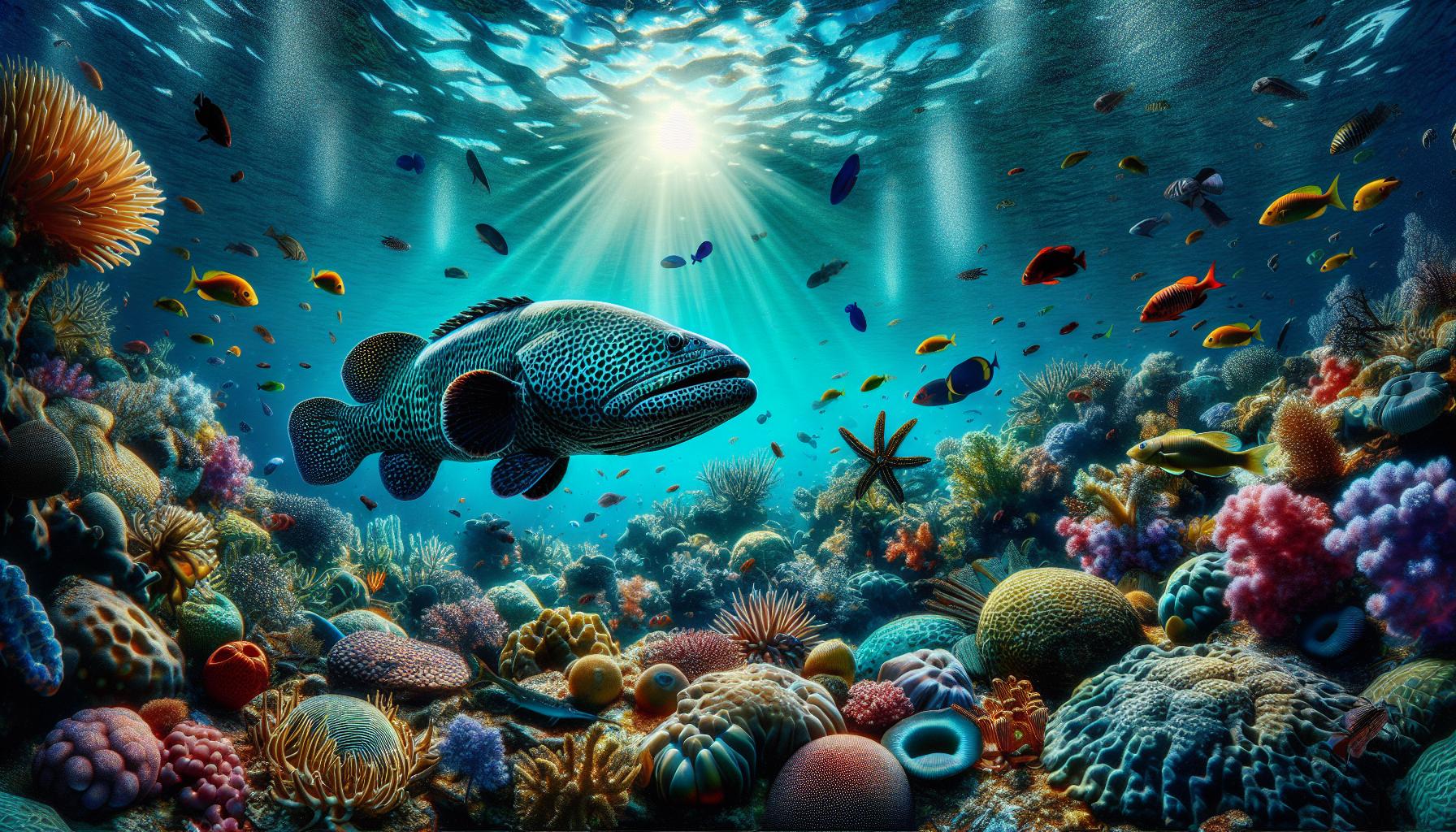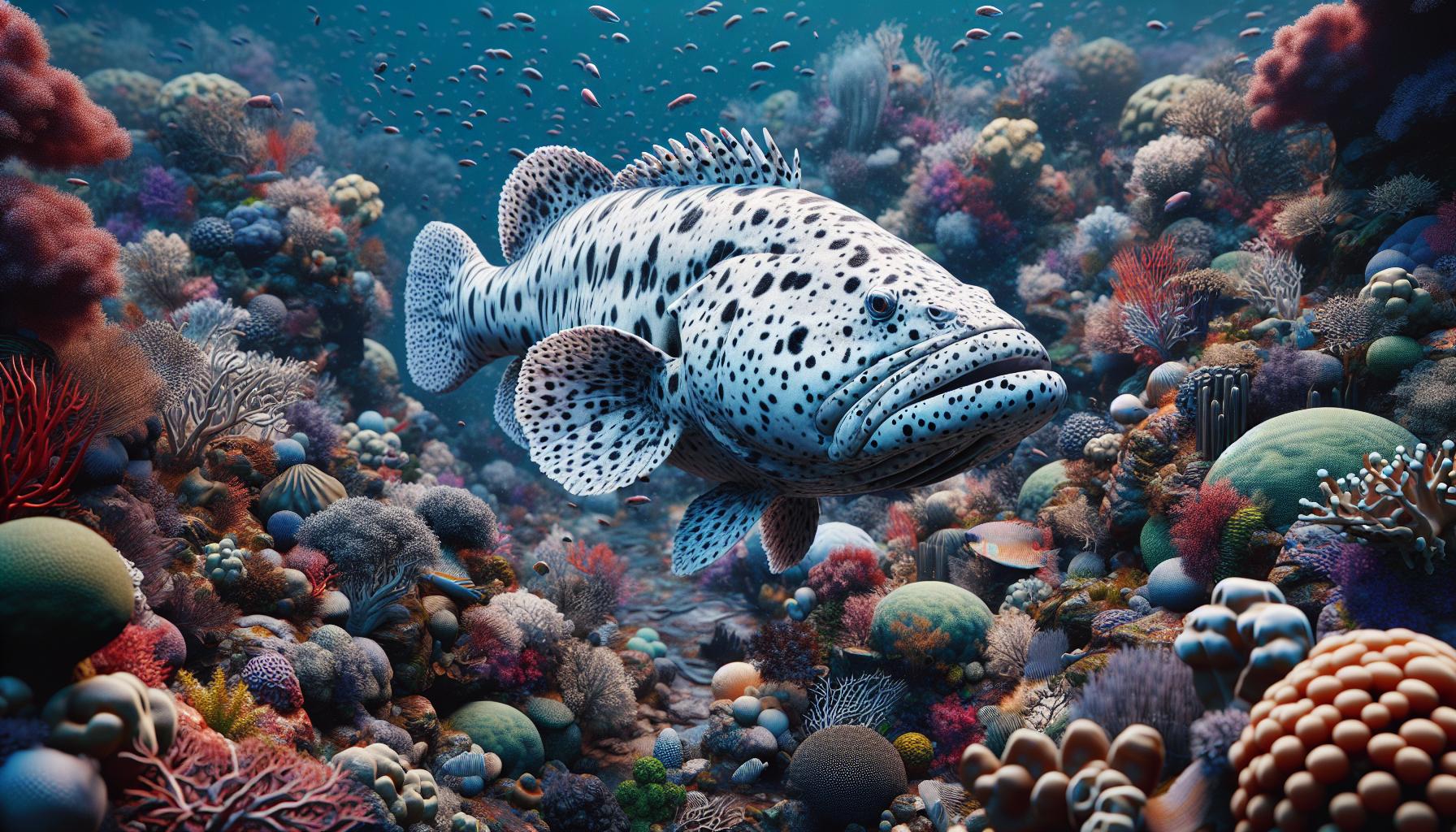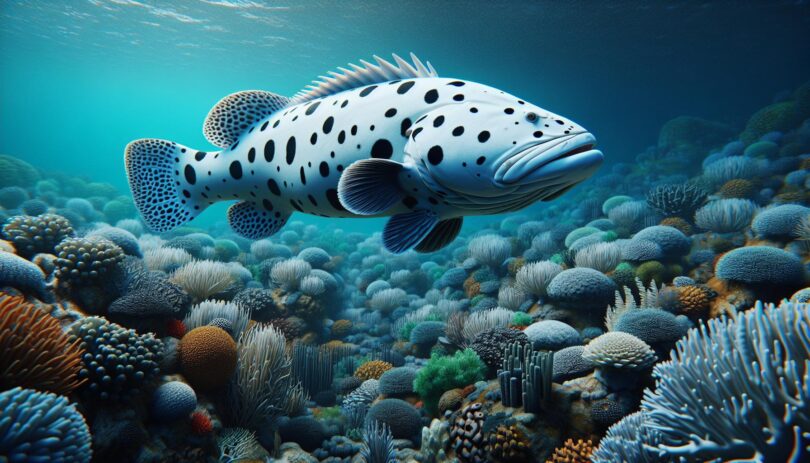The Panther Grouper, a striking figure in the marine world, has always captured my fascination. Known for its bold, black spots against a white body, it’s not just a visual marvel but also a topic of intrigue among aquarists and marine enthusiasts alike. Diving into the world of this magnificent species, I’ve discovered there’s much more than meets the eye.
From their unique habitat preferences to their surprising behaviors, Panther Groupers are a testament to the wonders of aquatic life. Whether you’re considering adding one to your aquarium or simply eager to learn about this captivating creature, I’m here to share insights that will deepen your appreciation for these underwater beauties.
Key Takeaways
- Panther Groupers are captivating marine creatures indigenous to the Indo-Pacific region, thriving in vibrant coral reefs and lagoons with depths up to 100 feet.
- Their physical appearance is marked by a stark white body adorned with black spots, aiding in camouflage, with adults potentially growing up to 24 inches (61 cm) in length, making them apex predators in their habitat.
- These groupers have a carnivorous diet focusing on ambush predation, adapting their feeding habits as they grow from juveniles to adults to include a variety of meaty foods like fish, crustaceans, and squid.
- Panther Groupers are protogynous hermaphrodites with a unique reproductive strategy that ensures population balance; they breed annually, influenced by water temperature, with external fertilization and pelagic eggs.
- Solitary in nature, Panther Groupers exhibit territorial behavior, defending their chosen habitats against rivals while showing adaptability and curiosity in aquarium settings, highlighting their importance in maintaining biodiversity within coral reef ecosystems.
Habitat of the Panther Grouper

When diving into the natural world of the Panther Grouper, I’ve always been fascinated by their remarkable habitat preferences. Originating from the Indo-Pacific region, these majestic creatures thrive in the coral reefs and lagoons, areas brimming with life and color. The intricate ecosystems they prefer offer not just beauty but a complexity that suits their predatory lifestyle. It’s no wonder they’ve become a symbol of underwater diversity.
Their residence in these vibrant ecosystems is defined by water depths ranging from shallow environments to areas that reach up to 100 feet. This variation exposes the Panther Grouper to a wide array of potential prey and shelter, crucial for their survival and well-being. The crystal-clear waters in these regions contribute to the optimal conditions for their growth and reproduction, making their habitat as essential as it is striking.
In my exploration, I’ve learned that the lighting conditions of their natural habitat play a significant role in their behavior. The Panther Grouper’s distinct markings are not just for show; they serve as camouflage within the sun-dappled waters of their coral reef homes. This adaptation showcases the grouper’s evolution in response to its environment, illustrating a perfect balance between form and function.
Temperature is another critical factor in the Panther Grouper’s habitat. Typically, they thrive in waters that are between 74°F to 82°F (23°C to 28°C), a range that supports their metabolic processes and ensures a conducive environment for hunting and breeding. This temperature range, typical of their natural habitat, underscores the need for precise conditions to maintain their health and vitality in captivity.
Understanding the habitat of the Panther Grouper deepens our appreciation for these majestic fish and the environments that foster their existence. It’s a testament to the intricate balance of marine ecosystems and the creatures that inhabit them.
Physical Characteristics of the Panther Grouper

When I delve into the physical traits of the Panther Grouper, it’s clear why this species stands out in the aquatic world. These fish are a stunning display of nature’s artistry, with a unique pattern that easily catches the eye. Their bodies are predominantly white, adorned with a multitude of black spots. These spots are not just for show; they play a critical role in camouflaging the Panther Grouper among the coral reefs and rocky substrates of its natural habitat.
One of the most striking features of the Panther Grouper is its size. As adults, they can grow impressively large, often reaching up to 24 inches (61 cm) in length. This size makes them one of the larger species found within the coral reefs of the Indo-Pacific. Their size, combined with their distinctive patterning, positions them as apex predators within their ecosystem.
| Trait | Description |
|---|---|
| Average Length | 24 inches (61 cm) |
| Color | White with black spots |
| Habitat | Coral reefs and lagoons |
| Role | Apex predator |
The Panther Grouper’s body is not only remarkable for its size and coloration but also for its structure. These fish possess a robust, laterally compressed body that aids in agility and speed, enabling them to dart through coral reefs and crevices with ease. Their large mouths and sharp teeth are perfectly adapted for their carnivorous diet, allowing them to consume a variety of prey with efficiency.
Furthermore, the Panther Grouper has large, expressive eyes that are indicative of their keen senses, particularly sight. This sensory adaptation is vital for spotting prey in the dappled light of their reef homes. It’s these characteristics that not only make them formidable predators but also fascinating subjects for marine biologists and aquatic enthusiasts alike.
As I explore the Panther Grouper’s physical characteristics, I’m continually amazed at how these elements contribute to its survival and dominance within the marine ecosystem.
Feeding Habits of the Panther Grouper

Delving into the feeding habits of the Panther Grouper reveals an intriguing aspect of its behavior that solidifies its position as a dominant predator in the marine ecosystem. Known for their carnivorous appetite, these groupers have a diet that primarily consists of a variety of meaty foods, including smaller fishes, crustaceans, and squid. What sets them apart is their unique hunting strategy paired with their striking physical attributes.
Firstly, ambush predation is the cornerstone of their feeding strategy. By utilizing their distinctive white bodies with black spots for camouflage, Panther Groupers can blend seamlessly with their surroundings. This allows them to lie in wait for unsuspecting prey, launching a swift and decisive attack when the moment is right. Their large mouths and sharp teeth make short work of their catch, demonstrating the effectiveness of their natural design.
The diet of Panther Groupers changes as they grow, showcasing their adaptability. Juveniles tend to focus on small crustaceans, while adults are bold enough to target larger, more challenging prey. This transition not only highlights their growth but also ensures a balance in the reef’s ecosystem, as Panther Groupers help control the population of certain marine species.
| Age Group | Primary Diet |
|---|---|
| Juveniles | Small crustaceans |
| Adults | Larger fish, crustaceans, squid |
Feeding in captivity presents its own set of challenges and considerations. Aquarium enthusiasts and professionals need to mimic their natural diet to ensure their health and longevity. This typically involves offering a variety of seafood, from shrimp to squid, ensuring that the Panther Grouper receives the nutrients it needs to thrive. Understanding these feeding habits is crucial for anyone looking to keep a Panther Grouper in an aquarium, providing a glimpse into the complexity of marine life and the interconnectedness of the marine ecosystem.
Reproduction and Life Cycle of the Panther Grouper
In the fascinating world of marine biology, understanding the reproduction and life cycle of a species like the Panther Grouper is key to appreciating its role in the ecosystem. These groupers have a unique reproductive strategy that contributes significantly to their population dynamics and ecological impact. I’ve delved into the science to bring these insights to life, focusing on hermaphroditism, breeding patterns, and growth cycles.
Panther Groupers are protogynous hermaphrodites, meaning they’re born female and have the ability to turn male as they age. This transformation usually occurs when the dominant male of a group dies or when there’s a significant lack of males to ensure successful breeding. This fascinating capability ensures that a balance between male and female groupers is maintained, optimizing reproductive potential. The exact triggers for this sex change are continually being researched, with factors like social hierarchy and environmental conditions playing crucial roles.
The breeding season of the Panther Grouper is notably influenced by water temperature and occurs once a year, aligning with the warmer months. During this period, males become highly territorial, displaying vibrant colors to attract females. A singular male can mate with multiple females, who release eggs that are then fertilized externally. The fertilized eggs are pelagic, drifting with ocean currents until they hatch. This dispersal strategy increases the survival rate of the offspring by spreading them over a wide area, reducing the potential for predation on concentrated populations.
| Aspect | Characteristic |
|---|---|
| Reproductive Type | Protogynous Hermaphrodite |
| Breeding Season | Annually, during warmer months |
| Fertilization | External |
| Egg Strategy | Pelagic; dispersed by ocean currents |
| Sex Change Triggers | Social hierarchy and environmental conditions |
As larvae, Panther Groupers are subject to high mortality rates, with only a few surviving to adulthood. Those that do survive undergo a dramatic transformation, growing rapidly in the safety of the reefs and estuaries which offer ample food and shelter. This early-stage growth is crucial, forming the foundation of their dominance in the reef ecosystem as they mature into formidable predators.
Behaviors and Interactions of the Panther Grouper
Delving deeper into the world of the Panther Grouper, their behaviors and interactions within the marine environment reveal much about their role in the ecosystem. Known for their solitary nature, Panther Groupers are typically loners except during breeding seasons. This preference for solitude is significant in their hunting strategy, where being alone aids in successful ambushes of prey.
These groupers are territorial, with adults establishing and defending specific areas within coral reefs or rocky substrates. The size of their territory often reflects their size and strength, with larger Panther Groupers controlling prime spots that offer abundant food resources and suitable hiding places for ambushing prey. This territorial behavior underscores the importance of dominance and survival in the wild.
Interactions with other marine species vary but are often predicated on the Panther Grouper’s predatory nature. Smaller fish and invertebrates are potential meals, leading to a cautious relationship with these species. However, Panther Groupers coexist relatively peacefully with larger species that do not compete for the same food sources. Observations have shown them sharing territories with such species without conflict.
Interestingly, Panther Groupers exhibit a remarkable adaptability in their interactions when housed in aquariums or marine parks. They can become relatively accustomed to human presence and may even exhibit curiosity towards divers and caretakers. This adaptability is a testament to their intelligence and complex behavioral patterns.
The intricate behaviors and interactions of the Panther Grouper within their natural habitats and artificial environments highlight their significance in the marine ecosystem. Understanding these dynamics is crucial for their conservation and the preservation of the delicate balance in their native coral reef communities. Their behaviors not only illustrate their role as predators but also their contribution to the biodiversity and health of coral reefs.
Conclusion
Exploring the Panther Grouper has taken us through a fascinating journey from their striking appearance to their unique life cycle. Their role as a formidable predator within coral reef ecosystems cannot be overstated. With their adaptability in both the wild and artificial environments, it’s clear they are a species of great interest not only to marine biologists but also to aquarium enthusiasts. However, their conservation is key. As we’ve learned about their breeding patterns and territorial nature, it’s evident that understanding and respecting their habitat is crucial for their survival and the health of coral reefs. Let’s continue to marvel at these magnificent creatures while advocating for their protection and the preservation of their natural environment.
Frequently Asked Questions
What is a Panther Grouper?
The Panther Grouper is a marine fish known for its striking appearance, with a white body covered in black spots. It’s a predator that lives among coral reefs and rocky substrates, primarily feeding on smaller fish, crustaceans, and squid.
How does the Panther Grouper feed?
The Panther Grouper feeds by using its unique white and black spotted body as camouflage, allowing it to ambush prey such as smaller fish, crustaceans, and squid.
Is the Panther Grouper a hermaphrodite?
Yes, the Panther Grouper is a protogynous hermaphrodite, meaning they are born female and have the ability to turn male as they age. This is a common trait among certain fish species.
How often do Panther Groupers breed?
Panther Groupers breed once a year, usually during the warmer months. Their fertilized eggs drift with the ocean currents until they hatch, spreading the species across different marine environments.
Are Panther Groupers solitary or social?
Panther Groupers are known for their solitary nature. They exhibit territorial behavior and are often found alone, unless during breeding season. Despite their adaptability to artificial environments, they maintain this solitary behavior.
Why is understanding Panther Groupers important?
Understanding the behavior, feeding habits, and reproduction of Panther Groupers is vital for their conservation. Knowledge about these fish helps in the preservation of coral reef communities, where they play an essential role as predators.

